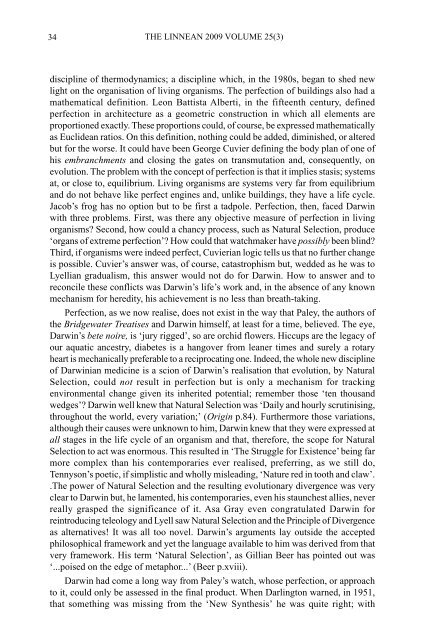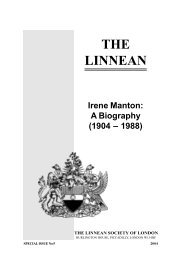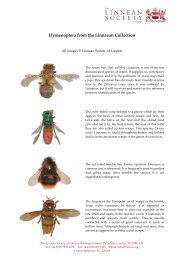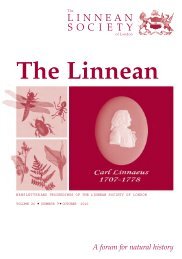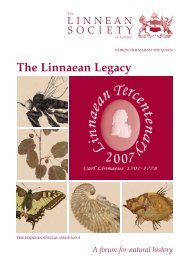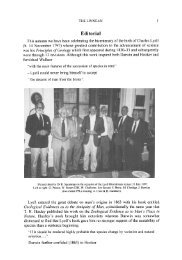Vol 25, no 3, October - The Linnean Society of London
Vol 25, no 3, October - The Linnean Society of London
Vol 25, no 3, October - The Linnean Society of London
Create successful ePaper yourself
Turn your PDF publications into a flip-book with our unique Google optimized e-Paper software.
34<br />
THE LINNEAN 2009 VOLUME <strong>25</strong>(3)<br />
discipline <strong>of</strong> thermodynamics; a discipline which, in the 1980s, began to shed new<br />
light on the organisation <strong>of</strong> living organisms. <strong>The</strong> perfection <strong>of</strong> buildings also had a<br />
mathematical definition. Leon Battista Alberti, in the fifteenth century, defined<br />
perfection in architecture as a geometric construction in which all elements are<br />
proportioned exactly. <strong>The</strong>se proportions could, <strong>of</strong> course, be expressed mathematically<br />
as Euclidean ratios. On this definition, <strong>no</strong>thing could be added, diminished, or altered<br />
but for the worse. It could have been George Cuvier defining the body plan <strong>of</strong> one <strong>of</strong><br />
his embranchments and closing the gates on transmutation and, consequently, on<br />
evolution. <strong>The</strong> problem with the concept <strong>of</strong> perfection is that it implies stasis; systems<br />
at, or close to, equilibrium. Living organisms are systems very far from equilibrium<br />
and do <strong>no</strong>t behave like perfect engines and, unlike buildings, they have a life cycle.<br />
Jacob’s frog has <strong>no</strong> option but to be first a tadpole. Perfection, then, faced Darwin<br />
with three problems. First, was there any objective measure <strong>of</strong> perfection in living<br />
organisms? Second, how could a chancy process, such as Natural Selection, produce<br />
‘organs <strong>of</strong> extreme perfection’? How could that watchmaker have possibly been blind?<br />
Third, if organisms were indeed perfect, Cuvierian logic tells us that <strong>no</strong> further change<br />
is possible. Cuvier’s answer was, <strong>of</strong> course, catastrophism but, wedded as he was to<br />
Lyellian gradualism, this answer would <strong>no</strong>t do for Darwin. How to answer and to<br />
reconcile these conflicts was Darwin’s life’s work and, in the absence <strong>of</strong> any k<strong>no</strong>wn<br />
mechanism for heredity, his achievement is <strong>no</strong> less than breath-taking.<br />
Perfection, as we <strong>no</strong>w realise, does <strong>no</strong>t exist in the way that Paley, the authors <strong>of</strong><br />
the Bridgewater Treatises and Darwin himself, at least for a time, believed. <strong>The</strong> eye,<br />
Darwin’s bete <strong>no</strong>ire, is ‘jury rigged’, so are orchid flowers. Hiccups are the legacy <strong>of</strong><br />
our aquatic ancestry, diabetes is a hangover from leaner times and surely a rotary<br />
heart is mechanically preferable to a reciprocating one. Indeed, the whole new discipline<br />
<strong>of</strong> Darwinian medicine is a scion <strong>of</strong> Darwin’s realisation that evolution, by Natural<br />
Selection, could <strong>no</strong>t result in perfection but is only a mechanism for tracking<br />
environmental change given its inherited potential; remember those ‘ten thousand<br />
wedges’? Darwin well knew that Natural Selection was ‘Daily and hourly scrutinising,<br />
throughout the world, every variation;’ (Origin p.84). Furthermore those variations,<br />
although their causes were unk<strong>no</strong>wn to him, Darwin knew that they were expressed at<br />
all stages in the life cycle <strong>of</strong> an organism and that, therefore, the scope for Natural<br />
Selection to act was e<strong>no</strong>rmous. This resulted in ‘<strong>The</strong> Struggle for Existence’ being far<br />
more complex than his contemporaries ever realised, preferring, as we still do,<br />
Tennyson’s poetic, if simplistic and wholly misleading, ‘Nature red in tooth and claw’.<br />
.<strong>The</strong> power <strong>of</strong> Natural Selection and the resulting evolutionary divergence was very<br />
clear to Darwin but, he lamented, his contemporaries, even his staunchest allies, never<br />
really grasped the significance <strong>of</strong> it. Asa Gray even congratulated Darwin for<br />
reintroducing teleology and Lyell saw Natural Selection and the Principle <strong>of</strong> Divergence<br />
as alternatives! It was all too <strong>no</strong>vel. Darwin’s arguments lay outside the accepted<br />
philosophical framework and yet the language available to him was derived from that<br />
very framework. His term ‘Natural Selection’, as Gillian Beer has pointed out was<br />
‘...poised on the edge <strong>of</strong> metaphor...’ (Beer p.xviii).<br />
Darwin had come a long way from Paley’s watch, whose perfection, or approach<br />
to it, could only be assessed in the final product. When Darlington warned, in 1951,<br />
that something was missing from the ‘New Synthesis’ he was quite right; with


